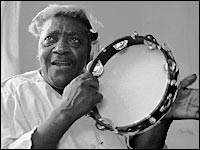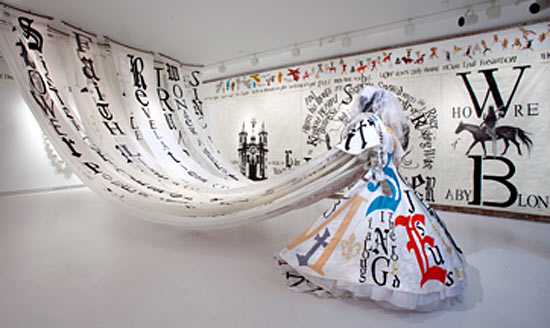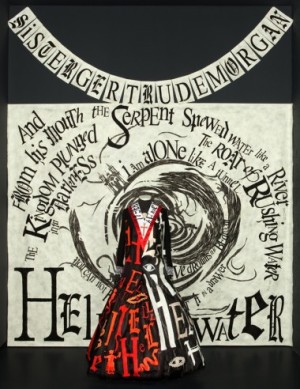by Marisa Martin, via wnd.com
She was a New Orleans fixture, raucously and righteously proclaiming the Kingdom of God day and night to all who had ears to hear. Like the prophet of Lamentations, she was an eccentric character, eliciting jeers or astonishment from bystanders as the crazy lady preached and sang on the corner with her tambourine.
Claiming divine instructions from God, Sister Gertrude Morgan faithfully wore a spotless, white nurse’s uniform symbolizing purity and holiness. In 1939 she launched four decades of personal warfare against the “headquarters of sin in the city” by running an orphanage and later a mission and preaching through the arts.
Morgan’s biblical vision tossed motley objects into one bright, burning creation that the public easily understood. “Messages from God” came in the form of poems, songs and paintings on discarded window shades and pieces of Styrofoam. Her art served a higher purpose than recycling though, as colorful visual aids for her sermons, such as “New Jerusalem with Jesus is My Airplane.”
Wasn’t Sister Gertrude an unwitting pioneer of the mixed-media installations that are now common?
Her life’s projects, such as the “The Everlasting Gospel Mission,” the uniforms and repeated imagery might even fit the description of an immersion alternative reality (only lacking the technology.) Morgan’s reality and projects were very real and holy in her mind, though, a focused spiritual journey that bridged both life and death.
In 2005, years after Sister Gertrude’s death, a comprehensive collection of her art was shown for the first time at the New Orleans Museum of Art. Critic Michael Kimmelman of the New York Times was impressed, extolling her art as “what it means to say art is a calling” and claiming that “it would be heaven if works like hers were eternally before our eyes.”
Did Sister Gertrude’s life really make a real difference? God alone knows, but she has become an unlikely muse to at least a few artists in the secular world in spite of her oddness and the always unpopular message of impending doom barking at her heels.
One of the most interesting is artist Lesley Dill and her magnificent installation, first at Arthur Roger Gallery and still circulating: “Hell Hell Hell Heaven Heaven Heaven: Encountering Sister Gertrude Morgan & Revelation” (2010). Dill is well known for her fascination with Emily Dickinson and incorporation of lettering, poetry and literature into feminist and spiritual themes.
Morgan’s life left with Dill lots of material for her visually riveting installation. Seizing on Sister Gertrude’s call to model the “Bride of Christ” by her life, Dill’s centerpiece is two monumental gowns; a dark dress symbolizing Morgan’s past life and a white “bridal” dress radiating streams of poetry and apocalyptic scripture through the space. Themes on the dress and great drawings were some of Morgan’s favorites: the Antichrist, Revelations, the Whore of Babylon, Hell and Heaven.
Fabric unfurls from the 6-foot bridal dress, which speaks through hand-sewn fabric letters on glory, calling and hopes of heaven. Its nemesis is echoed by a darkly clothed manikin placed before an oversize drawing recalling a “serpent spewing water, rushing rivers” and other apocalyptic images. The entire space is staged as ongoing battles of contrast between heaven and hell. Keeping with theme, Dill drapes oversized glass beads sandblasted with references to poems by Morgan and Dickinson as well as relevant texts by Pablo Neruda, Katherine Ann Porter and Franz Kafka.
English major Dill could easily make several connections between Emily Dickenson and Gertrude Morgan: the sparse but very individual style of verse; rejection of social expectations for women; preoccupation with eternity and death; and of course the white dress Emily always wore for reasons she took to her grave.
Dill’s work is beautifully and carefully crafted, revealing a complex, deep philosophy but it lacks one thing the Sister’s cruder art achieved: a unified statement – in her case, of faith.
In Dill’s work, bits of biblical quotes and poetry wheel around the walls and figures like a textual tornado in antique gothic scripts. The tug of constant conflict between heaven/hell and good/evil run about unresolved, leaving an unsettled feeling as if wandering into the fitting room of a mad tailor.
It was logical to ask Dill about her own religious beliefs, since so many of her projects focus on spirituality and transcendent themes.
She mentioned an Episcopal child baptism and later a Baptist “rebaptism” as part of a project, which has got to be one of the most unusual reasons to convert I’ve heard yet. Dill didn’t make a clear confession to any faith, which surprised me because of the energy and power of her installations.
Her muse Sister Gertrude was explicit and unwavering about religion and demoted her art entirely to its service. Speaking about her creations, she denied much involvement.
“He’s the One that made me do it, He deserves the praise” she humbly insisted.
“He moves my hand; do you think I would ever know how to do a picture like this by myself?” she once asked an interviewer.
But Dill hasn’t been the only artist moved by Sister Gertrude’s piety and dramatic creations.
Shortly after Hurricane Katrina, composer and performer King Britt remixed Sister Gertrude’s songs and presented them, doing live backgrounds for relief concerts. The result was a recording released by Preservation Hall in 2005 “King Britt presents Sister Gertrude Morgan,” which combined the evangelist’s recordings from 1970 with a just a bit of contemporary reworking. It’s been used in episodes of Miami Vice and HBO’s True Blood (soundtrack was nominated for an Emmy).
I think Sister Gertrude would be truly surprised by this flurry of attention in recent times and wonder what it means. Secular artists using themes on heaven, death and hell will be with us always, since it’s impossible to mine more fascinating or fertile imagery than that of the Bible. Does this signify a return of Christianity to the art world? ‘Tis a possibility devoutly to be wished, but reviewers of Dill’s spiritually loaded exhibits generally tiptoe right past it.
David Brown of the Southeastern Center for Contemporary Art is an exception. He sees larger issues in Dill’s work, such as the “question of contemporary art’s role in spiritualism” and differences between the “world of organized religion and the mystical revelations” of individuals. Personally I would love to see dozens of exhibits along those lines. Now that would be heavenly.
You may see a variety of Dill’s work in a traveling exhibit, including “Encountering Sister Gertrude Morgan & Revelation” at Jordan Schnitzer Museum of Art, University of Oregon, Eugene: Sept. 28-Dec. 9, 2012, and the Halsey Institute for Contemporary Art in Charleston, S.C.: Jan. 25-March 8, 2013.




